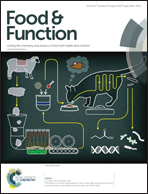Hydroxysafflor yellow A (HSYA) targets the NF-κB and MAPK pathways and ameliorates the development of osteoarthritis
Abstract
The inflammatory environment has been demonstrated to be strongly associated with the progression of osteoarthritis (OA). HSYA, the main active component in the medical and edible dual purpose plant safflower, has previously showed significant anti-inflammatory effects in several diseases. In the current study, the protective effects of HSYA in the inhibition of OA development and its underlying mechanism were examined by both in vitro and in vivo experiments. Our data indicated that interleukin-1 beta (IL-1β) induced over-production of pro-inflammatory cytokines, such as nitric oxide (NO) and prostaglandin E2 (PGE2); also, the expression of cyclooxygenase-2 (COX-2), tumor necrosis factor alpha (TNF-α), interleukin-6 (IL-6) and inducible nitric oxide synthase (iNOS) were all inhibited by pretreatment with HSYA in a dose-dependent manner (2.5 to 40 μM). Furthermore, HSYA attenuated IL-1β-induced degradation of the extracellular matrix (ECM) by decreasing the expression of metalloproteinases (MMPs) and thrombospondin motifs 5 (ADAMTS5). Mechanistically, HSYA suppressed IL-1β-induced activation of the nuclear factor kappa B (NF-κB) and mitogen-activated protein kinase (MAPK) cascades. Meanwhile, molecular docking studies revealed that HSYA has excellent binding abilities to p65, extracellular signal-regulated kinase (ERK), p38 and c-Jun N-terminal kinase (JNK). In addition, the protective effects of HSYA were observed in a surgically induced mouse OA model. In summary, this study provides evidence that HSYA can be applied as a potential therapeutic agent in the treatment of OA.



 Please wait while we load your content...
Please wait while we load your content...